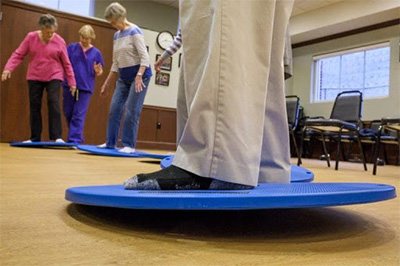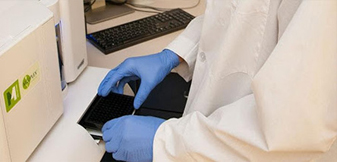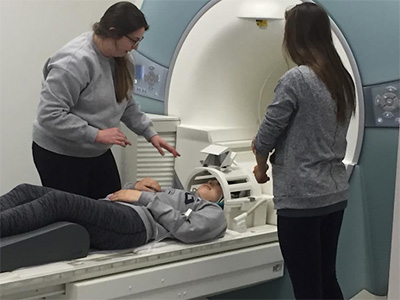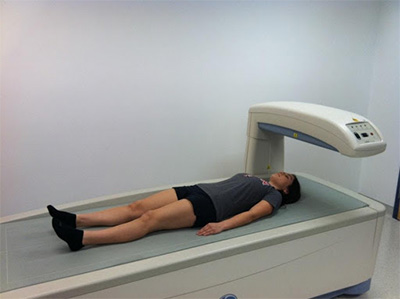Because the work of the CWHW is largely interdisciplinary in nature, we collaborate with multiple research laboratories across campus to understand the facilitators and barriers that influence injury, illness and disease processes, and that promote mental and physical well‐being in girls and women. Research laboratories we are currently collaborating with are noted below. We look forward to adding to our list of affiliates as we expand our research and collaborations over the next 3-5 years. Please contact us at cwhw@uncg.edu if your laboratory has an interest in affiliating with the Center.
Applied Neuromechanics Research Laboratory
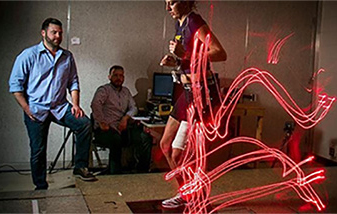 The Applied Neuromechanics Research Laboratory (ANRL) focuses on understanding risk factors for lower extremity injury and joint disease, particularly those associated with anterior cruciate ligament (ACL) injury in the female athlete.The mission of the ANRL is to promote clinically driven research and quality education that bridges scientific inquiry and clinical practice to reduce injury risk. This is accomplished through an interdisciplinary approach to research and education that attracts and integrates students, faculty, and clinicians from diverse professional backgrounds, experiences and scientific perspectives. The lab is equipped with state-of-the-art instrumentation to assess human muscle performance (e.g., muscle strength and power), anthropometrics (joint structure and alignment), joint laxity, balance, and biomechanics.
The Applied Neuromechanics Research Laboratory (ANRL) focuses on understanding risk factors for lower extremity injury and joint disease, particularly those associated with anterior cruciate ligament (ACL) injury in the female athlete.The mission of the ANRL is to promote clinically driven research and quality education that bridges scientific inquiry and clinical practice to reduce injury risk. This is accomplished through an interdisciplinary approach to research and education that attracts and integrates students, faculty, and clinicians from diverse professional backgrounds, experiences and scientific perspectives. The lab is equipped with state-of-the-art instrumentation to assess human muscle performance (e.g., muscle strength and power), anthropometrics (joint structure and alignment), joint laxity, balance, and biomechanics.
The lab is located adjacent to a research gymnasium for assessment under more field-based exercise simulations. Research focused on ACL injury risk in women has been funded by the National Institutes of Health, the National Science Foundation, National Football League Medical Charities, the NCBC Biotechnology Center, and the National Athletic Trainers Association. CWHW Director, Dr. Sandy Shultz is the Co-Director of the ANRL.
Balance Analysis and Training
The Balance Analysis and Training (BAT) focuses on identifying and correcting balance impairments associated with musculoskeletal injury. More specifically, our agenda examines a variety of balance tests and measures to identify balance impairments. Assessments are then conducted to determine anatomical, biomechanical, and sensorimotor factors that contribute to balance deficiencies. Customized therapeutic interventions for impairments are then administered to enhance balance.
Current research projects include both faculty and graduate students focused on identifying postural stability assessments and outcome measures that are sensitive to detecting balance impairments, quantifying anatomical, biomechanical, and sensorimotor factors that contribute to balance deficits, administering traditional therapeutic interventions that are specific to correcting deficiencies and balance and exploring complementary therapeutic interventions (stochastic resonance stimulation, interactive video games) for enhancing balance. The BAT lab is directed by Dr. Scott Ross.
Exercise Physiology Research Laboratory
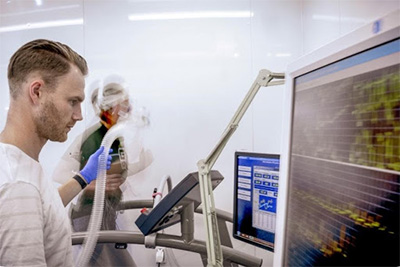
The Exercise Physiology Research Laboratory (EPR) is a 2,400 square-foot in the Coleman Building on the UNCG campus. The laboratory includes state-of-the-art instrumentation for body composition assessment, including BODPOD, hydrostatic weighting, bioelectrical impedance and skinfold calipers (a dual-energy x-ray absorptiometry machine is also shared with the Nutrition Department).
The laboratory also houses an environmental heat chamber, and equipment for resting and exercise oxygen consumption assessment and monitoring; ECG monitoring, recording and proper interpretation; performance measures on cycle ergometers (Monark and Lode) and treadmills; and a full biochemical laboratory enabling both tissue and blood analysis for various metabolic, signaling and stress response measures. Dr. Laurie Wideman, a member of the CWHW Advisory team, serves as a co-director of the Laboratory.
Exercise and Endocrinology Lab
The Exercise and Endocrinology Lab (E2) focuses on the impact of either acute exercise or chronic training, disease or injury on the endocrine system. The endocrine system is complex and encompasses several major hormonal axes that influence the physiological function of a myriad of tissues. Since the synchrony of these systems is vital for understanding the pathology of disease, our lab is interested in the analysis of hormonal profiles and the potential utility of heart rate variability as a non-invasive indicator of endocrine influence.
The E2 lab is also interested in cardiometabolic risk factor development across the lifespan, especially during the transition from adolescence to young adulthood. During this time frame two major life changes usually occur; the adolescent leaves home and also begins the transition to full time work. These transitions represent increasing independence for young adults and are critical times for the development of lifelong patterns of health behaviors, such as sleep, exercise and diet. We are interested in understanding the influence of early childhood self-regulation on the development of cardiometabolic risk and health behaviors during this crucial transition period. Dr. Laurie Wideman, a member of the CWHW Advisory team, serves as the director of the laboratory.
Gateway Magnetic Resonance Imaging Center
The Gateway Magnetic Resonance Imaging (MRI) Center is located at UNCG’s Gateway University Research Park in the Joint School of Nanoscience and Nanoengineering, within a 10-minute drive (4 miles) from UNCG’s campus. The facility is equipped with a Siemens Magnetom Tim Trio 3 Tesla MRI scanner, and a variety of RF coils to accommodate imaging research needs.
Multiple ongoing CWHW studies currently use this equipment to image anatomical structures and functional brain scans to understand sex differences in injury risk. For example, anatomical scans provide insight into sex differences in intrinsic ligament properties that increase a female’s susceptibility for knee injury, and functional brain scans help us understand the central (brain) control of lower extremity movements as well as the neurological outcomes associated with concussive and sub-concussive head trauma among female athletes. Dr. Randy Schmitz, a faculty affiliate of the CWHW, serves as the Director of Musculoskeletal Imaging for the Gateway MRI Center.
Human Nutrition Research Laboratories
The Human Nutrition Research Laboratories in the Department of Nutrition include anthropometric equipment available for field research, exercise testing equipment, a phlebotomy and anthropometric measurement room, dual-energy X-ray absorptiometer (DEXA) bone density unit, and Nutrition Data System for Research software which is the gold standard for dietary intake analysis. The laboratory is utilized by Dr. Shriver, a member of the CWHW Core Advisory Team, and collaborator on the Healthy Girl’s Initiative.
Synthetic Biology Laboratory
Synthetic Biology Laboratory (SBL) in the Joint School of Nanoscience and Nanoengineering manipulates living microbial biofilms to generate novel biomaterials that can be used in medical and industrial applications. Natural biomaterials have a hierarchical organization from the nanoscale to the macroscale. This organization is responsible for many of the amazing, emergent properties of biomaterials like wood, bone, or shell. The SBL has demonstrated that simple single-celled organisms, like bacteria and fungi, provide several advantages over more complex cellular systems for the biological fabrication of novel synthetic nanomaterials.
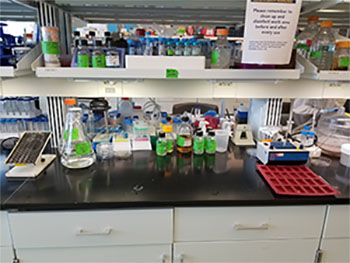
The development of these materials have the potential to provide new green and sustainable biomaterials for a variety of applications in the biomedical and other industries. Specifically, cellulosic nanomaterials have intriguing mechanical properties which may find application in prosthetics and biomedical devices that require non-linear or atypical mechanical properties. Towards that end, SBL Director Dr. Dennis LaJeunesse and his Doctoral Student Hunter Holden are currently collaborating with ANRL Co-Directors Drs. Shultz & Schmitz and Kinesiology doctoral student Beth Bacon on the potential to use these materials to develop a dynamic knee support for the purposes of injury prevention in young female athletes and military personnel.
Virtual Environment for Assessment and Rehabilitation Laboratory
The Virtual Environment for Assessment and Rehabilitation Laboratory (VEAR) focuses on understanding the role of complex behavior in gait and postural control, and to develop novel rehabilitation interventions to enhance motor behavior—including the use of virtual reality and smartphone technology. As we navigate the environment, we must continually adapt our gait to avoid or accommodate obstacles such as stairs, other people or moving cars. After an injury, aging, or pathology, the ability to adapt gait to the environment is compromised, leading to an increased risk of falling and injury.
To restore a patient’s ability to appropriately interact with the environment – termed functional mobility – a physical rehabilitation program is employed. Unfortunately, the decision of when functional mobility has been restored is largely subjective, making it difficult to know when a patient should be released to return to dynamic activity, such as sports or active duty.
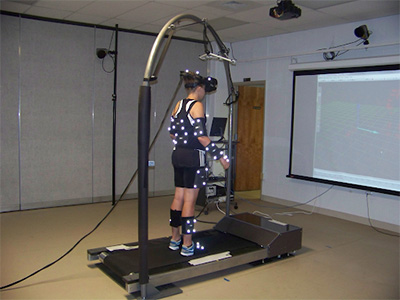
Releasing the patient prematurely could lead to an increased risk of further injury. To this end, the VEAR Lab objectively measures functional mobility using a dynamic systems approach, which is then merged with virtual reality and smartphone technology to enhance the assessment, tracking, and rehabilitation of a variety of clinical populations. Research in our lab has been funded by the National Institutes of Health (NIH), the Department of Defense (DoD), the US Navy, Health Resources and Services Administration (HRSA), and the Women’s Football Foundation (WFF). Take a virtual tour.
